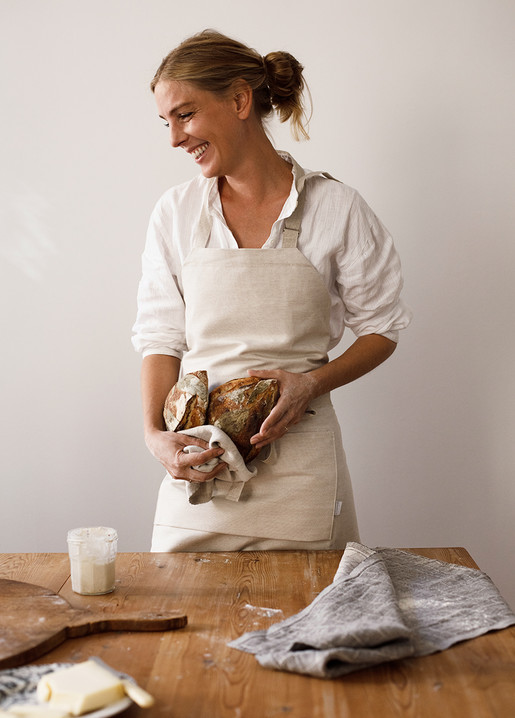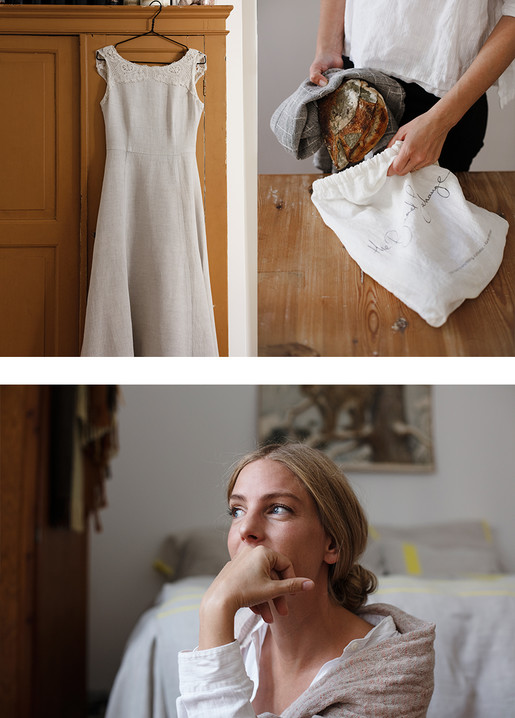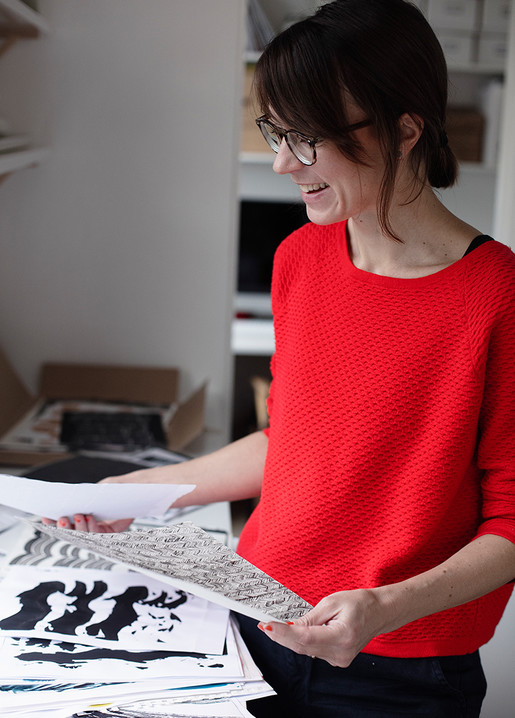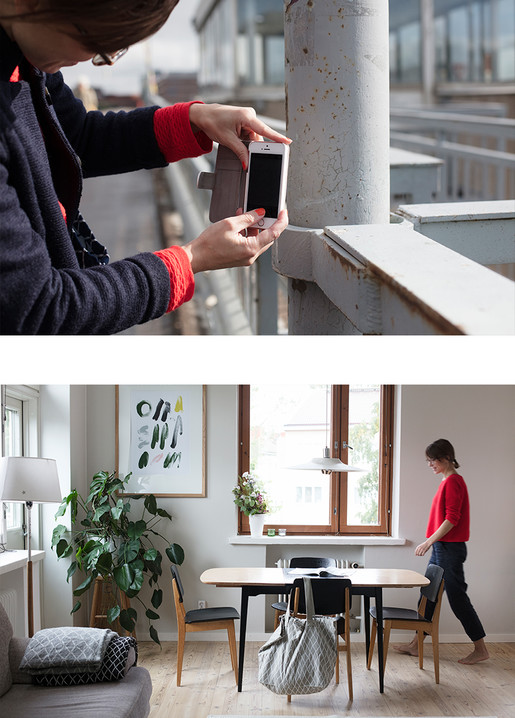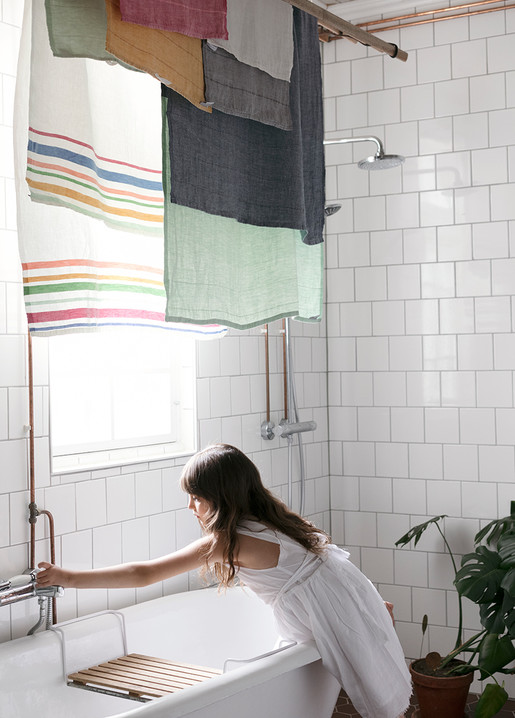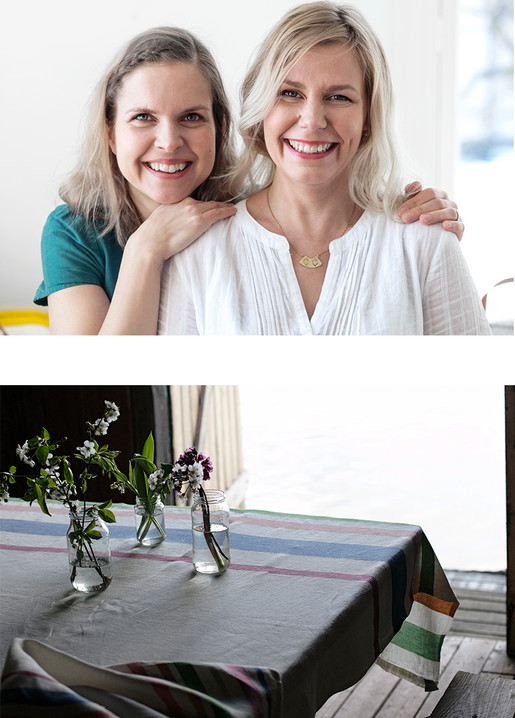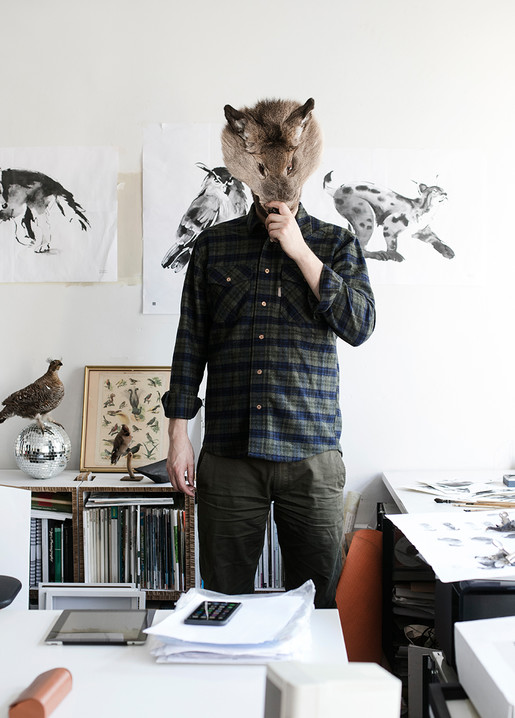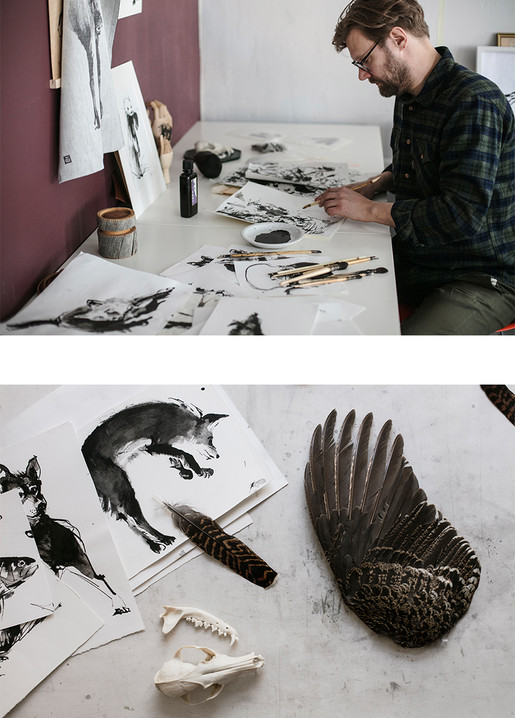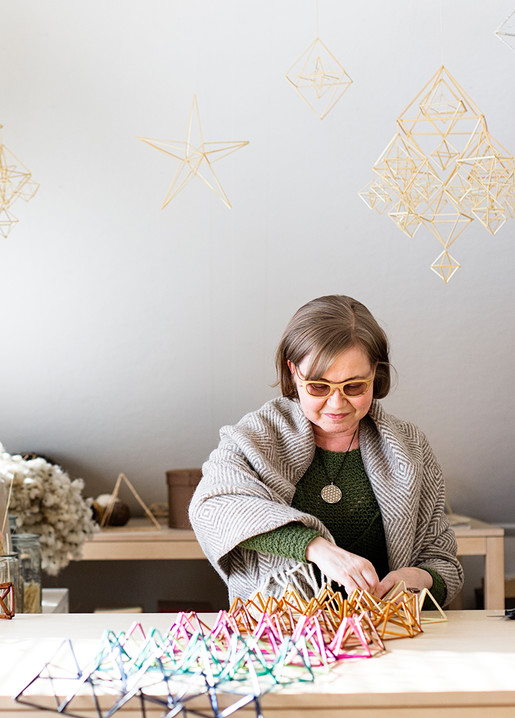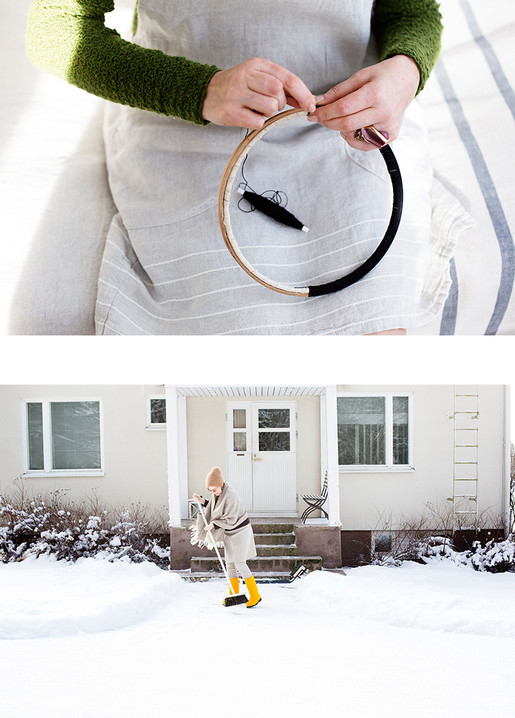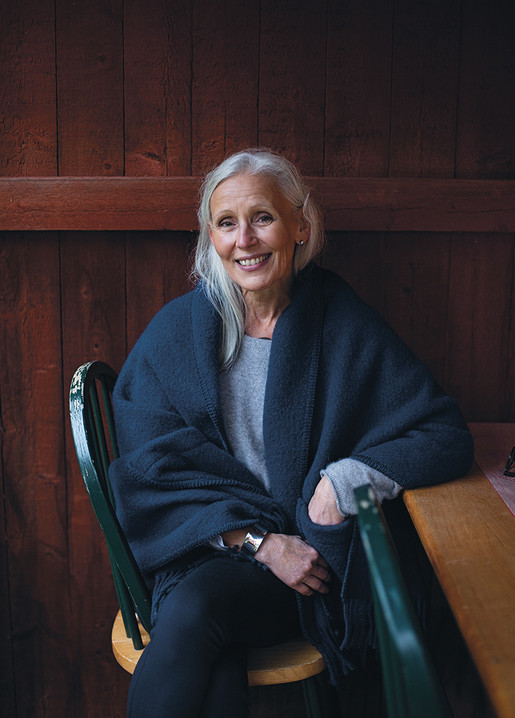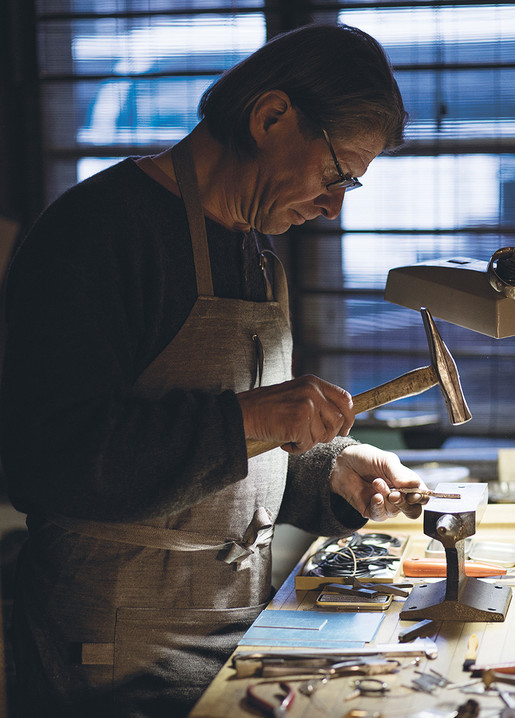Collecting Stories with Bread
Stories are always present in author and blogger Malin Elmlid's life, from baking bread to sewing clothes from authentic materials.
Malin started her project The Bread Exchange simply because, living in Berlin, she couldn't find white sourdough bread and started baking her own. "I had too much and I gave it away", she says. At first, people brought her gifts but when they started offering her money, she refused. To her, stories and people's positive energy are more interesting. "It was nice to have an area in my life that didn't involve money", Malin says. Soon, Malin started traveling around the world with her sourdough. She documents these travels on her blog The Bread Exchange. She's also written a book with the same name.
Malin's life seems to revolve around stories and a love for people. She celebrated her wedding in early autumn, and describes the day as a patchwork of all the people she's loved. She designed the wedding dress herself from Kaste linen towels woven by Lapuan Kankurit, and combined them with lace from her great aunt. "We've had our second base in Finland for two years, so it felt natural that the material came from here." Before the wedding, she took a week for herself and travelled to Bangkok to make the dress together with a familiar tailor. During the same trip, she also sewed linen shirts for her son from Lapuan Kankurit scarves. The process of making linen and wool products draws her to them. "Lapuan Kankurit tells a story through their material", she says.
History appeals to Malin and is always present in her life. She finds history flowing through everything, and if something distinctly lacks a history, she doesn't find it very interesting.
To her, history is the soul of everything. "It just makes everything more colourful", she describes. The same applies to bread. Baking with your mother's or grandmother's recipe will always be better than anything else. "All the stories of my encounters are the secret fourth ingredient of my breads", she says.
Something as simple as a loaf of bread can connect people in exceptional ways. "Bread has to be shared, because we don't finish it on our own", Malin describes.
To her, bread is a metaphor for food in general. Being invited to share a meal is a strong gesture – a friendly invitation. "Bread also plays a role in many religions, but I think it goes beyond that. Bread is the smell of home. It's the definition of home." It's hard to imagine any other item that would have so much value. "Bread can't turn against you", Malin says and lets out a warm laugh.
Her journeys have certainly taken Malin to phenomenal places and allowed her to share bread with exceptional people. To her, that means all of them. "I think that's the key to why The Bread Exchange stayed successful. I didn't capitalize it or choose who to trade with", she analyses. Each moment brings something new and inspiring to her life. "A trade with a school class can be as inspiring to me as a trade with the biggest art collector in Germany", she says. Each experience carries wonder and a constant passion for story.
1/ PANAMA MINI apron 70x80 cm, col. linen, linen-bio-organic cotton, design Lapuan Kankurit
2/ UNIQUE HANDMADE wedding dress, made of KASTE linen towels
3/ LASTU tea towel 48x70 cm, col. white-grey 100% washed linen, design Masaru Suzuki
4/ HETA scarf 65x205 cm, col. beige-orange, wool-linen, design Heta Vajavaara
Moments of Revelation
Textile designer Reeta Ek (Young Designer of the Year 2017) sees patterns in places others might overlook.
Surface, structure, rhythm. These elements are at the heart of textile designer Reeta Ek's work, and they can be found everywhere, even in the smallest of details. They are patterns on the pavement and art her children paint. "My son brought me a drawing. He'd poked the paper with a felt pen so that the colour spread", Reeta describes. He thought it might make a nice pattern – and she agreed. "The sketch is saved on my computer", she says and smiles.
As a visual person, Reeta is constantly discovering new ideas. Her computer stores hundreds of sketches that she regularly revisits to find inspiration. "You develop an intuition for what makes ideas interesting", she says. "Ultimately, it's the work itself that inspires. You have to go through many scribblings to find the one good concept." To her, any idea has the potential to grow into an intriguing design.
AALLONMURTAJA, one of Reeta's most recent designs for Lapuan Kankurit, was inspired by the Lauttasaari Bridge. She was walking around with her camera, ready to photograph anything that might stir her imagination. The wavy surface on the bridge pavement reminded her of sketches she'd made. "It was a moment of revelation, noticing that my sketches were linked to the things I saw around me." Making that new connection sparked her interest in the design. "It expressed my thinking back to me", she describes the experience.
One of Reeta's first designs for Lapuan Kankurit was TULITIKKU in 2012. Since then, she's worked together with the company on several projects and finds the work a joy. "I think every Finnish designer wants to work with them. They represent honest, down-to-earth work", she says. "It's wonderful that they weave their products in Finland."
Reeta describes her design process as part of a whole, and working with Lapuan Kankurit ensures that each step of the process works, from choosing the right materials to packaging and presenting the finished product.
Design Forum Finland recently chose Reeta as Young Designer of the Year – an honour which has since resulted in many interviews and events. Normally, her workdays consist of everything from sketching to ordering prints and answering e-mails. "If I'm sketching, I like to dedicate the day to just that", she says. Ideally, she'd reserve several days in a row for discovering new ideas. Once the sketches are done, she scans them onto her computer. Reeta says that employing technology feels like a natural part of her design process. "Adding colours helps me see the repeatable patterns the sketch could turn into." Although the computer in a pivotal part of her work, Reeta says that she always begins sketching by hand.
"I think my design process has become more precise over the years", Reeta analyses. Experience has taught her what interests her and how to focus on those elements. She also mentions that kindness towards yourself and your work is an important part of finding and maintaining inspiration. Downplaying your own ideas never works. "I hope that the more I work, the kinder I become towards myself", she says, then lets out a laugh. "I'd like to remember that things aren't always that serious."
Finding the Light in Finland and Kenya
Design company Mifuko merges Finnish and Kenyan elements to keep tradition alive.
"Kenya is an important part of our life and business", says textile artist and designer Minna Impiö. "It's also where we draw our inspiration." Minna and colleague Mari Martikainen founded Mifuko in 2009. The company's products are known for being environmentally and ethically sustainable. Their Kiondo baskets are handmade in Kenya. Mifuko also follows the principles of Fair Trade and strives to create work opportunities – they currently employ five hundred artisans in Kenya.
For Lapuan Kankurit, Minna and Mari have designed the linen collection TSAVO and MERU. The scarves, towels, blankets, and cushion covers combine Scandinavian design with African colours and are woven in Lapua, Finland. "Lapuan Kankurit shares our appreciation of authenticity", Mari says. "It's important for both companies that the artisans are visible in their work." All Mifuko artisans sign their work, making each product unique.
TSAVO and MERU showcase distinctly Kenyan colours, which is a new addition to the Lapuan Kankurit products. It's an opportunity for both companies to learn and grow their own point of view. "I think we've inspired each other", Mari says. All in all, the two find working together with Lapuan Kankurit a pleasure. "It's great to cooperate with a company that shares our values", Mari says. As cooperation started, Minna and Mari visited the weaving mill in Lapua. Minna describes the techniques as a wonderful starting point for designing textiles. "As a textile designer, it's good to see a Finnish company that's also international", Mari adds.
Nature inspires Minna and Mari's work, whether in Finland or Kenya. "The warm afternoon light in Kenya is incredible", Minna describes. Mari adds that light in Kenya is different from anywhere else. The contrast between bright light and absolute darkness fascinates the designers, and the varying landscapes and colours are a constant source of inspiration.
Kenyan landscape consists of coasts, highland, mountains, and savannas, which all sound very different from Finnish nature. However, Minna and Mari find surprising parallels between the two countries. "The savanna almost resembles a field. It reminds us of Ostrobothnia", Minna says. In Finland, the two especially appreciate the purity of nature and the freedom to roam. "Finnish light is also exceptional, especially in the summer", she continues.
Mifuko's appreciation for artisans has had a profound impact in Kenya. "Traditional techniques have been revived because of our work", Mari says. Minna adds that before Mifuko started working in the area, traditional artisanal crafts were disappearing. "Now these people get steady income for their work", she says. "It's also had a huge social impact. Mothers-in-law are passing the knowledge and techniques on to the women in the family." Local artisans meet every week in workshops and discuss matters outside of work as well, reviving a sense of community in the area. "We appreciate traditional craftsmanship", Minna says. Mari continues: "It's one of the most important values we share with Lapuan Kankurit."
The Wonders of Wilderness
Artist and designer Teemu Järvi's work captures the wild simplicity of nature.
Teemu Järvi describes his work as observing and interpreting nature. "I want to capture that moment of coming face to face with a wild animal, because it's over in an instant", he says.
The animals may run away, but drawing them captures the childlike wonder Teemu says is present whenever he's in nature. Some of these moments are also captured in the kitchen textiles he designed for Lapuan Kankurit. "I'm the type who questions everything. But I don't question nature", he says.
Teemu's background in furniture design is still visible in his work. "I'm interested in the entire process from idea to finished product", he says. His designs are always part of a whole, which also reflects his relationship with the forests and lakes of Finland. "Nature can deepen our understanding of ourselves."
Teemu's passion for nature also fuels his cooperation with Lapuan Kankurit. His illustrations are combined with natural materials, which gives them a uniquely authentic feeling: the textiles are made to last for generations. "I wanted the KÄPY table runner to look like someone just scattered pinecones on the table", Teemu describes one of his designs. Lapuan Kankurit has known Teemu for several years and praise him for his passion and commitment to his work. Valuing nature and sustainability connects the designer with Lapuan Kankurit, whose products are known for natural colours, materials, and designs.
Teemu utilises tools that also celebrate Finnish nature. "I use reed pens and ink", he explains. While he says he usually likes order and coherence, he enjoys the mystique these tools enable. "I fell in love with chance. You can't fix ink and I find that's where I take risks", he ponders. Teemu describes himself as a hunter-gatherer – an aspect he also embraces in his work. Instead of bamboo, his pens are made with Finnish reed. "I feel like I'm drawing nature with nature itself", he describes his work.
"I'm happiest when I'm roaming in wilderness", Teemu Järvi says. For him, nature is – and has been ever since he was a child – a place where his thoughts and creativity can develop in peace. He finds switching from the fast-paced urban life to a calm state of creativity requires effort. Spending time in nature takes him back to a simple way of living.
"Urban life is constantly changing. That's why roaming in nature feels so grounding", he says. "Things don't require immediate reaction." He may be an adult now, but for him, being in nature is the same it's always been.
Eija Koski – The Skymaker
The Finnish word "himmeli", which is a form of straw art, originates from the sky. People also often ask if there is something holy in himmelis. Certainly there is something in it.
The rye field waves in the summer wind, and the soft light through the leaves above makes the yard feel like a cosy nest. Only a lone swallow breaks the silence, drawing lines on the canvaslike blue sky. This very place, in the midst of Ostrobothnian plains, is an artist's dream come true.
Is there anything more beautiful than a reflection on an old shed's chalk wall? Himmelist Eija Koski's world-famous artwork hangs here; straw yellow, graphic black, even colourful. Almost three meters long, the largest one hangs noble, while the smallest one fits in a tiny box. People around the world are mad about this artwork – in Japan, Finland, the young and the old. Himmeli is not something old any more, it's trendy in modern homes, public spaces and galleries.
Passion and Purity
Also the modern, yet traditional textiles of Lapuan Kankurit feel at home here, says Eija Koski.
– There is a unique spirit in Lapuan Kankurit textiles, just as in my artwork. They embrace something very Finnish, but at the same time they are modern and express passion. I appreciate the fact that the linen textiles are made nearby, from natural ingredients.
The wool and linen products are in use also in the artist's summer cottage.
– There we sit on the porch, enjoying the sea breeze, all cuddled up in bath gowns. Natural materials feel so soft and warm.
Wild Nature
Eija Koski has always loved the nature, woods and its offerings. In her atelier, she also arranges courses on wild herbs and mushrooms. Organic flour from the surrounding fields is sold in brown paper bags. – We also run an organic farm, and it is just fabulous to follow the seasons: how the nature awakens in the spring and how the sprouts turn into crop. When the dusk falls, all kinds of wild animals visit our yard – even moose. I often ride my bike to pick mushrooms in the woods. The wild nature is so wonderful; the universal laws of beauty are still visible.
Universal Beauty
Why is it that himmeli touches people around the world?
– First I thought that it is the material, rye, which is considered the king of grain.
– For me, beauty equals harmony. I found Plato's idea that there is eternal beauty, which consists of lines and mathematical patterns. And there it was: himmeli actually is an octahedron, one of the five basic solids. Now I understand why himmeli is so widely considered beautiful.
– I often think how lucky I am having the privilege of working with nature and creating pure beauty, touching souls. I have turned my passion into a profession.
Authenticity That Spans Generations
The foggy fields welcome the visitor into Johanna Talso and Juha Koskela's home. The surroundings seem to celebrate the couple whose artisanal lifestyle is built on the appreciation of nature and tradition.
Johanna organises an annual craft fair where artisans and customers meet in 18th century historical surroundings, and sews historically accurate clothing from linen fabrics. "I grew up on a farm, so the landscape of my soul is a field," Johanna says.
When duty calls, Johanna doesn't count the hours. Ideas follow her everywhere she goes, and she sees that as a blessing. "An artisan's mind works differently," Johanna says and laughs. "We're a little weird like that." Her husband Juha Koskela is an awarded goldsmith, so craftsmanship is always present in their life.
Timeless, long-lasting materials and products have a special role in Johanna's life. She appreciates design and objects that endure. "They're not confined to present moment," she says. Textiles that can be passed down to future generations are valuable to her. In fact, she reveals that she still has some of the original linens designed by the world-renowned textile artist Dora Jung in the 1960s. The beauty of the linens hasn't faded over time. Lapuan Kankurit is currently reviving Jung's designs according to the original drawings and instructions, proving that their elegance really does span generations.
Johanna uses authentic materials, because they look and feel right. She sews clothing from Lapuan Kankurit linen fabrics, and Juha uses precious metals in his jewellery. "Tradition, history, nature, and authenticity all go hand in hand," Johanna says. The couple agrees that they didn't understand the significance of traditions when they were younger. "Now those strong values are more present in Finnish culture", Juha analyses. Johanna says that her family has always saved fun, beautiful, or handmade items. "I have my great-grandmother's linen tablecloths, and they're still in great condition," she smiles. She hopes that families continue to pass down items that are made to stand the test of time.
While craftsmanship is valued in Finland and all over the world, it still remains a marginal phenomenon. "Is it a trend to value craftsmanship, or is it really valued?" Johanna wonders. The pricing of handmade crafts is still occasionally debated. However, trendsetting magazines have also started to introduce artisanal products. "Crafts will always compete with mass-produced items," Juha adds. He's noticed that people also value individuality, and that's when trendy labels don't matter: "People want to create their unique appearance with clothing and jewellery." Johanna and Juha don't seem worried about craftsmanship disappearing altogether. "It'll always be there, sometimes stronger and sometimes weaker," Juha says. "They're appreciated more, because people don't make crafts themselves anymore."
As craftswoman and organiser of the 18th century craft fair, Johanna has experiences both sides of the artisanal community. It might be a small group of people, but special at that: "The artisanal community is close-knit," she smiles. Juha agrees. "There's a small group of people who don't want to fit in," he says, "and that's what we call craftsmanship."
Pages
- « first
- ‹ previous
- 1
- 2
- 3


